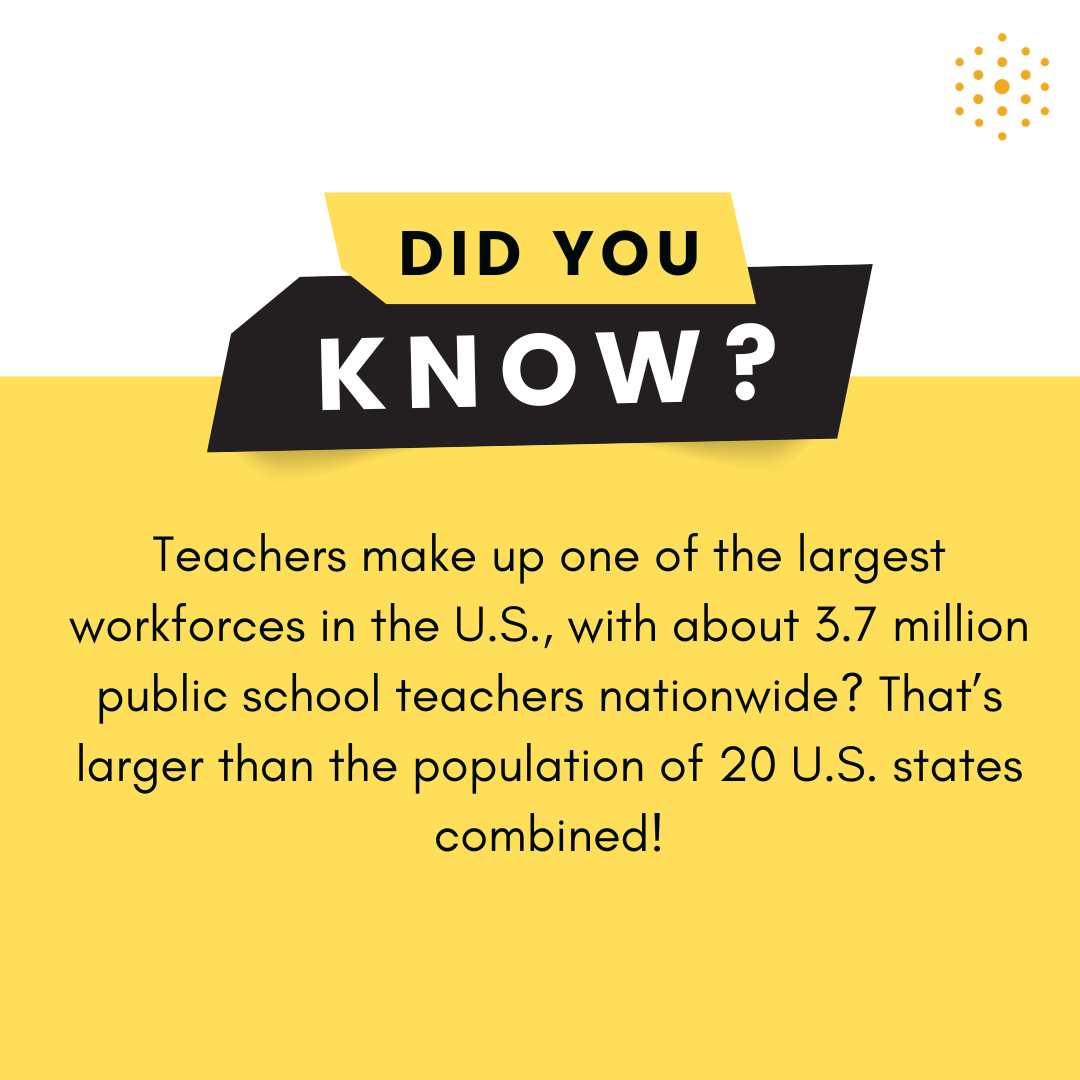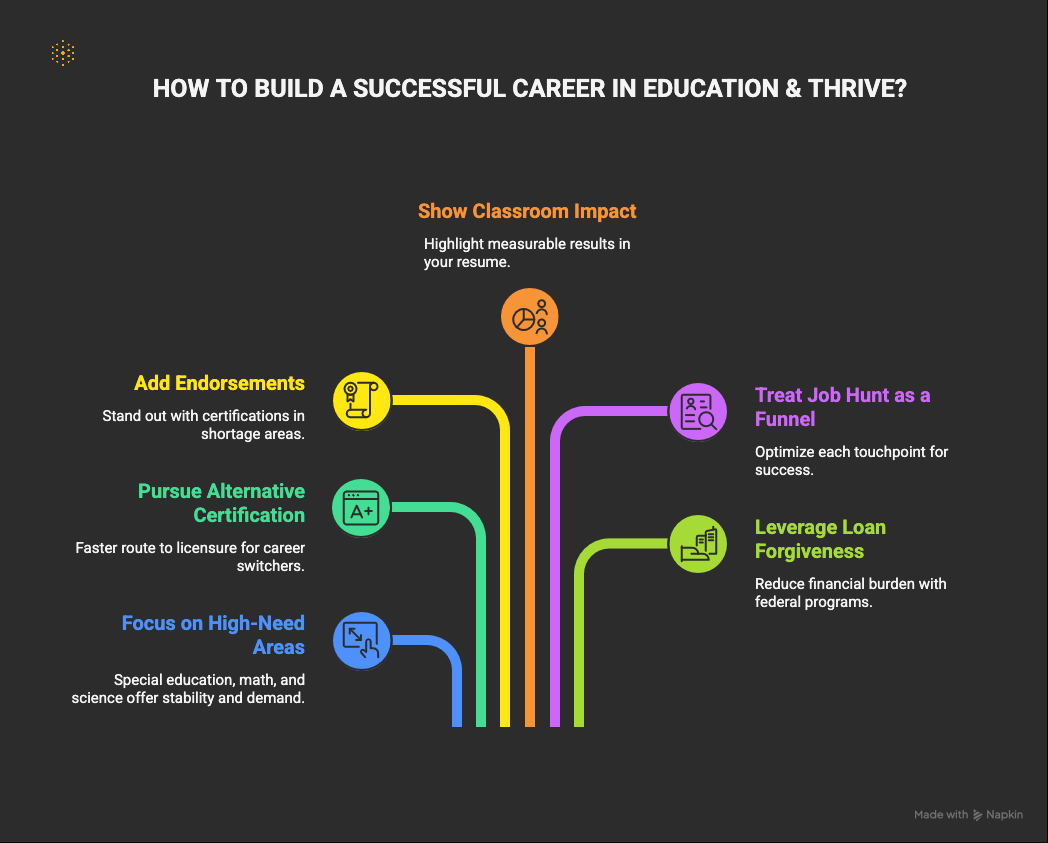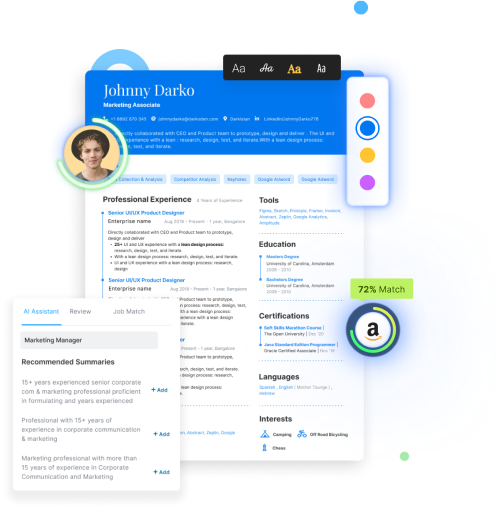What’s the fastest, most reliable way to break into K–12 education and thrive?
Target high-need subjects (Special Education, Math, Science), map your state’s licensure or alternative-certification path, and stack priority endorsements (e.g., SPED + ESL). Show outcome-first impact on an ATS-friendly resume, run your search like a funnel (LinkedIn + STAR-based interviews), and leverage PSLF and Teacher Loan Forgiveness to maximize take-home value.
Education has always been more than a profession, it’s a cornerstone of community stability and upward mobility.
Today, it’s also one of the few fields where the numbers show demand isn’t slowing anytime soon.
Between 2024 and 2034, education and library roles are projected to generate nearly 890,300 openings every year according to U.S. Bureau of Labor Statistics.
For anyone considering a career, or a career switch into teaching, this means unprecedented opportunity.
This guide breaks down 6 practical steps to help you enter the field and thrive.
1. Go Where the Demand Won’t Dry Up
Education offers stability, competitive pay, and consistent hiring needs.
The median wage sits at $59,220, and the demand is being felt on the ground.
Heading into the 2024-25 academic year, 74% of U.S. public schools reported at least one unfilled teaching vacancy according to NCES School Pulse Panel, via K-12 Dive.
And these shortages aren’t random - they cluster around the same hard-to-fill roles year after year: special education, math, and science.
Action step: If you want to maximize your odds of landing and keeping a role, focus on one of these high-need areas.
For example, pursuing dual credentials in Special Education and Math could make you one of the most sought-after candidates in your state. Start by checking your district’s HR requirements and aligning your credential path accordingly.
2. Know Your State’s Fastest Path to Licensure
Every public K-12 teaching role requires a license. The details - tests, coursework, clinical hours, are state-specific.
And if you’re switching careers, many states now offer alternative routes to certification.
Instead of completing a full undergraduate education gree, you can qualify if you already hold a bachelor’s.
Typically, you pass subject exams, enroll in a state-approved program, and teach under a provisional license with mentoring while finishing coursework.
Once requirements are met, your provisional license converts to a standard teaching certificate.
Action step: Check your state DOE website and jot down 4 things:
- Exams you’ll need to pass
- Required clinical or student-teaching hours
- Background check details
- Whether you’ll need a post-hire master’s degree
If you already have a bachelor’s, compare the timeline for traditional prep programs versus state-approved alternative certification.
Sometimes the latter gets you in a classroom faster.
Also Read: How to make a preschool teacher resume?

3. Add Endorsements That Hiring Managers Chase
Want to stand out? Stack certifications in areas schools struggle to staff. Here’s what the numbers say:
- Special Education Teachers: Median pay $64,270.
- Instructional Coordinators: Think curriculum design or professional development. Median pay $74,720, with ~21,900 openings a year and +1% growth projected (2024–34).
- Adult/ESL Teachers: Median pay $59,950. Public-school roles typically require a license.
Action step: If you’re undecided, do a quick sub assignment or observation in two shortage areas. Then commit to one main endorsement and a secondary skill (like SPED + ESL).
Also Read: What are some jobs former teachers can get?
4. Show Classroom Impact Like It’s a KPI
A resume that reads like a lesson plan won’t cut it. Schools want proof you can drive outcomes.
Think measurable results: student growth, proficiency gains, intervention success, attendance boosts, or equity improvements.
Action step: Rewrite your bullets to show results first, then the action that got you there. Tailor each application by matching skills from the posting to your actual outcomes.
If you’re applying outside K-12 (say, private or nonprofit schools), translate your results into time saved, cost savings, or program metrics like PD completion or parent engagement.
Pro tip: Add a short skills section with your certifications, assessments (WIDA, LETRS), frameworks (MTSS/RTI), IEP platforms, and edtech tools.
5. Treat the Job Hunt Like a Funnel
Think of the hiring process the same way a marketer thinks about customer conversion. Each touchpoint, from your resume to the follow-up email, nudges decision-makers closer to saying “yes.”
- ATS-Friendly Materials: Most districts use applicant tracking systems (ATS). If your resume has odd formatting or too many graphics, it might never be seen by human eyes. Stick to clean, text-based formats and active-voice bullets.
- Your Digital Presence Matters: Principals and HR teams will Google you. A polished, keyword-optimized LinkedIn profile can make you discoverable in their searches. Bonus points if your endorsements or recommendations align with shortage areas like SPED or STEM.
- Ace the Interview: Don’t just prepare answers, practice delivering them with confidence. Use the STAR method (Situation, Task, Action, Result) to structure responses, showing clear impact while staying concise and engaging.
- Close Strong: Within 24 hours, send a short thank-you email that reiterates how your skills link directly to student outcomes. It keeps you top-of-mind and signals professionalism.
6. Don’t Leave Money on the Table
Let’s be real: teaching pays respectably but rarely extravagantly. The good news?
Federal loan forgiveness programs can make a massive difference in your take-home income if you know how to leverage them.
- Public Service Loan Forgiveness (PSLF): If you’re working in qualifying public schools, your payments under an eligible repayment plan can add up to complete loan discharge after 120 qualifying payments. That’s essentially 10 years of work before your balance disappears (Federal Student Aid).
- Teacher Loan Forgiveness: This one is faster. Highly qualified teachers in low-income schools or shortage subjects can receive up to $17,500 in forgiveness, a big boost if you’re teaching math, science, or special education.
Action steps: Confirm if your school is on the eligibility list (published by the Department of Education) and make sure your loans are consolidated into the right repayment program, this is where many teachers slip up and lose credit for years of payments.

Wrapping Up
Breaking into education doesn’t have to feel overwhelming.
By focusing on high-need areas, understanding your state’s licensure paths, and showcasing measurable impact, you put yourself in a strong position to land and grow in a teaching role.
And while the steps are clear, putting them into practice - especially crafting resumes that pass ATS, preparing for interviews, or polishing your digital presence, can still take time.
That’s where Hiration can help. Our AI-powered career suite is designed to make those pieces easier, so you can spend less time on logistics and more time on what matters: building a meaningful career in education.
Education Career Guide — FAQ
Where is demand strongest right now?
Special Education, Math, and Science are consistently hard to staff. Education and library roles collectively see large annual openings, making these areas the best entry points for stability and growth.
I have a bachelor’s. What’s the quickest licensure path?
Many states offer alternative certification: pass required subject exams, enroll in a state-approved program, teach on a provisional license with mentoring, then convert to standard certification after completing requirements.
Do I need a master’s to start?
It depends on your state. Some require a post-hire master’s within a set timeline; others don’t. Check your state DOE for exams, clinical hours, background checks, and degree expectations before you begin.
Which add-on endorsements help me stand out?
Stack credentials in shortage areas—e.g., Special Education plus ESL. Roles in curriculum/professional development (instructional coordination) are also valuable if they match your background and goals.
How do I show classroom impact on my resume?
Lead with outcomes, then actions (growth, proficiency, attendance, intervention results). Keep formatting ATS-friendly and include a concise skills block (assessments/frameworks/IEP platforms/edtech tools).
What interview framework should I use?
Use STAR (Situation, Task, Action, Result). Tie each example to posted competencies and quantify impact where possible to demonstrate clear, repeatable outcomes for students and programs.
How important is my digital presence?
Principals and HR will search online. Keep LinkedIn polished, aligned to shortage areas, and consistent with your resume. Recommendations and endorsements that match your target role help discoverability.
What loan forgiveness options should I know?
PSLF can discharge remaining federal loans after 120 qualifying payments in eligible public roles. Teacher Loan Forgiveness can provide up to $17,500 for qualifying teachers in low-income schools/shortage subjects. Verify school eligibility and repayment setup before applying.
I’m switching careers. What’s my first move?
Confirm state requirements, take required subject exams, observe or substitute in target classrooms, then choose a primary endorsement (e.g., SPED) plus a secondary (e.g., ESL) and pursue an approved alt-cert pathway.
Traditional prep vs. alternative certification—how do I choose?
Compare time, cost, and clinical hours. Traditional routes can be comprehensive; alt-cert often gets you into a classroom faster under a provisional license while you complete coursework.



